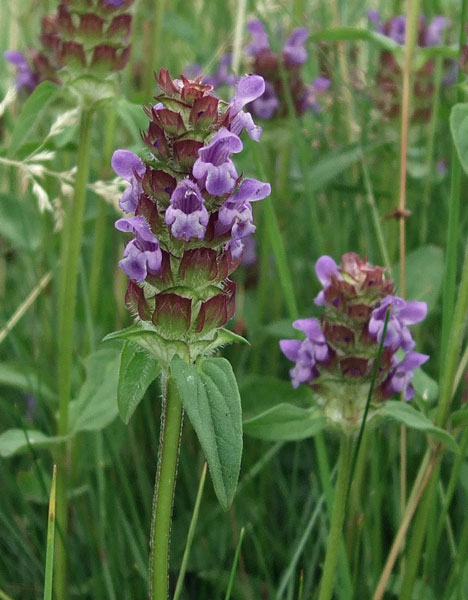 Botanical name: Prunella vulgaris
Botanical name: Prunella vulgaris
Family: Lamiaceae
General information
Selfheal grows on a wide variety of sites including grasslands, meadows, woodland, roadside, lawns and fine turf.
This herbaceous perennial plant has an affinity for moist, nutrient rich alkaline soil conditions.
Selfheal which is member of the mint family, spreads by seed and creeping underground runners (known as rhizomes) which root at intervals and it has a thick fibrous root system.
In managed turf it forms a dense mat, which can tolerate close mowing. If it is not controlled it will spread aggressive, eventually smothering out the grass.
Although it is particularly troublesome in managed turf, it is capable of growing to nearly 50 cm high when left undisturbed. For this reason it is often used in wild flower seed mixtures and its purple flowers is particularly attractive to bees and butterflies.
As its name suggests, selfheal has many medicinal uses. It can be used to stop bleeding and promote healing, it’s also used to treat heart disease. In Asia and South America it is used for treating minor cuts, bruises, burns and sores. The Chinese use it as a stimulant for treating liver problems.
As well as medicinal uses, selfheal is also edible, the leaves can be used in a salad, or added into a soup or stew. The leaves can also be boiled to make a nourishing herbal tea.
Identification
- Leaves: The leaves of selfheal are opposite and can grow 50 mm long and 20 mm across, although they are somewhat smaller in closely mown turf. They are oval or oblong shaped, light or dark green in colour and may have scalloped edges. The surfaces have prominent veins, are generally smooth, but light hairs may be present on rare occasions.
- Flowers: The small 2 lipped purple – violet flowers attract different insects and form in rings on oblong tubes that are about 1cm long. The upper lip of the flower is purple and hooded, while the lower is whitish and fringed. Each flower produces up to 4 seeds, with the flowering period between June and September.
- Roots: The roots are fibrous
Selfheal Images (click image to enlarge)
More images and free downloads of selfheal
Prevention and control
Promote optimum turf health with good practices such as adequate feeding, regular aeration and scarification to prevent selfheal and other weeds from invading.
Mow the lawn on a regular basis to prevent the seed heads from forming.
Selfheal can be removed by hand, using a grubber or small knife, taking care to remove all of the root.
On the chemical side of things, spot treating individual plants can prove very effective. If the infestation has been allowed to become more widespread, then the whole area may need to be treated, using a suitable selective weedkiller. If possible only treat the area infected by weeds to keep chemical use down to a minimum.
Selfheal is not a difficult weed to control using a selective herbicide and a single treatment is usually effective. The most suitable time for treating weeds in turf and lawns is during periods of strong growth, usually during late spring and early summer.
Recommended chemicals for the control of selfheal
2,4-D + Mecoprop-p
2,4-D + Dicamba
2,4-D + Dichlorprop-p
Mecoprop-p + Dicamba
Clopyralid + Fluroxypyr
Recommended products for selfheal control
Professional products (The user requires the appropriate certificate/s to apply these products)
Headland Relay Turf (Mecoprop-p, Dicamba, MCPA)
React Ultra (Mecoprop-p, Dicamba, MCPA)
Everris Praxys (Clopyralid, Fluroxypyr, Fluosulam)
Bayer Longbow (Mecoprop-p, Dicamba, MCPA)
Barclay Holster XL (2,4-D, Fluroxypyr, Dicamba)
Mascot Greenor (Clopyralid, Fluroxypyr, MCPA)
Mascot Crossbar (2,4-D, Flurosulam, Dicamba)
Vitax Esteem (2,4-D, Clopyralid, MCPA)
Products available for non-professional use (These products are available from garden centres and DIY stores)
Verdone extra (Clopyralid, Fluroxypyr, MCPA)
Resolva lawn weed killer (2,4-D, Mecoprop-p, MCPA, Dicamba)
Doff lawn spot weeder (2,4-D, Mecoprop-p, Dichlorprop-p)
Vitax Lawn Clear (2,4-D, Clopyralid, MCPA)
Vitax Green up weed & feed (Dicamba, MCPA)
Weedol lawn weed killer (Clopyralid, Fluroxypyr, MCPA)
Scotts lawn builder weed & feed (2,4-D, Dicamba)





